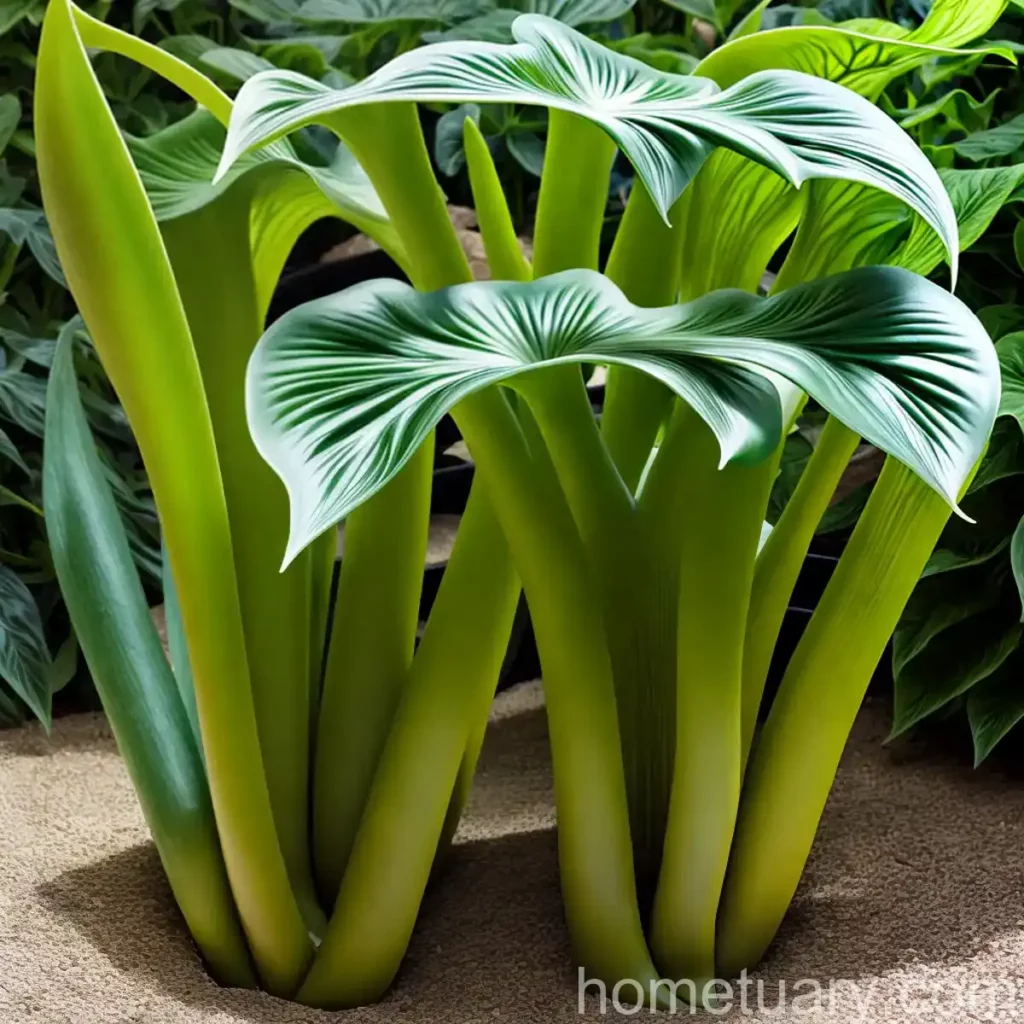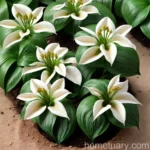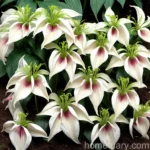Italian Arum (Arum italicum)
Italian arum, scientifically known as Arum italicum, is a striking perennial plant that is native to the Mediterranean region. This plant is famed for its attractive foliage and unique flowering habits, making it a popular choice for gardeners and landscapers worldwide. In this comprehensive guide, we will delve into the various aspects of Italian arum, from its cultural requirements to its common uses, diseases, and pests.
What is Italian Arum (Arum italicum)?
Italian arum, or Arum italicum, is a herbaceous perennial plant that belongs to the family Araceae. It is characterized by its vibrant, arrow-shaped leaves and distinctive spathe-and-spadix type of inflorescence. The plant typically grows to about 12-18 inches in height, with its lush foliage forming attractive clumps. It blooms from late spring to early summer, producing unique, hooded flowers that are often concealed by the plant’s foliage.
Key Takeaways
To gain a deeper understanding of Italian arum and its cultivation, maintenance, and uses, we will explore the following aspects in detail:
- Culture
- Uses
- Water Requirements
- Sunlight Needs
- Fertilization
- Soil Conditions
- Pruning
- Propagation
- Container Gardening
- Popularity
- Common Diseases
- Disease Diagnosis
- Common Pests
- Botanist’s Tips
- Fun Facts
- Links to External Resources
Let’s delve into each of these aspects to uncover the nuances of growing and caring for Italian arum.
Culture
Cultivating Italian arum is a rewarding endeavor, provided the plant’s cultural requirements are met. Consider the following cultural aspects when introducing Italian arum to your garden or landscape:
- Hardiness: Italian arum thrives in USDA hardiness zones 6-9, making it well-suited for temperate regions.
- Growing Season: It is best planted in the fall or early spring to allow ample time for establishment before the onset of harsh weather conditions.
- Soil: Well-draining, fertile soil with a slightly acidic to neutral pH (6.0-7.0) is ideal for Italian arum.
- Watering: While the plant tolerates dry conditions once established, regular watering is essential during the growing season, especially during prolonged periods of drought.
- Temperature: Italian arum prefers moderate temperatures and may require protection from extreme heat or frost.
Uses
Italian arum holds numerous uses in horticulture and landscaping, adding both aesthetic and functional value to outdoor spaces. The plant’s versatile applications include:
- Ornamental Purposes: Its striking foliage and unique inflorescence make Italian arum a coveted choice for ornamental gardens, woodland settings, and shaded landscapes.
- Ground Cover: The plant’s spreading habit and lush foliage make it an excellent ground cover option for shaded areas.
- Cut Flower: The unique flowers of Italian arum make for intriguing additions to floral arrangements and indoor displays.
- Wildlife Habitat: Italian arum may attract pollinators and wildlife, enhancing biodiversity in the garden.
The plant’s diverse uses make it a valuable addition to any garden or landscape design.
Water
Proper watering is crucial for the optimal growth and development of Italian arum. Understanding the plant’s water requirements is essential for maintaining its health and vigor. Consider the following guidelines for watering Italian arum:
- Establishment: Newly planted Italian arum should be watered regularly to facilitate root establishment. Ensure the soil is consistently moist but not waterlogged during the initial growth phase.
- Established Plants: Once established, Italian arum is relatively drought-tolerant. However, it benefits from occasional watering during dry spells, especially in the absence of natural precipitation.
- Container Plants: If growing Italian arum in containers, monitor the soil moisture closely and water when the top inch of the soil feels dry.
By adhering to appropriate watering practices, gardeners can ensure the sustained vitality of their Italian arum plants.
Sunlight
Italian arum displays a preference for partial to full shade, thriving in areas with dappled sunlight or filtered light. Understanding the plant’s sunlight needs is crucial for achieving optimal growth and performance. Consider the following aspects of sunlight exposure for Italian arum:
- Shade Tolerance: Italian arum is well-adapted to shaded environments, including woodland settings, shaded borders, and under the canopy of larger trees.
- Leaf Development: Partial to full shade encourages lush foliage development, enhancing the plant’s ornamental appeal.
- Sun-sensitive: Prolonged exposure to intense sunlight can scorch the plant’s leaves, leading to diminished aesthetic quality.
Adhering to these sunlight guidelines will contribute to the vigor and beauty of Italian arum in the garden.
Fertilizer
Fertilization plays a key role in supporting the growth and vitality of Italian arum. Providing the plant with essential nutrients ensures robust foliage and healthy flowering. Consider the following guidelines for fertilizing Italian arum:
- Fertilizer Type: Use a balanced, slow-release fertilizer with an NPK ratio of 10-10-10 or similar formulation. Alternatively, organic fertilizers such as compost or well-rotted manure can be applied in spring to enrich the soil.
- Application Frequency: Apply fertilizer once in early spring as new growth emerges, following the recommended application rates based on the specific product used.
- Even Distribution: Spread the fertilizer evenly around the base of the plant, avoiding direct contact with the foliage to prevent potential burns.
By incorporating proper fertilization practices, gardeners can promote the overall vigor and resilience of Italian arum plants.
Soil
Italian arum thrives in well-draining, fertile soil with a slightly acidic to neutral pH. Understanding the plant’s soil preferences is crucial for establishing optimal growing conditions. Consider the following soil-related aspects when cultivating Italian arum:
- Composition: Opt for a well-draining, loamy soil rich in organic matter, such as compost or leaf mold, to provide the plant with essential nutrients and structural support.
- pH Levels: Italian arum prefers a pH range of 6.0-7.0, indicating slightly acidic to neutral soil conditions. Conduct a soil test to assess and adjust the pH if necessary before planting.
- Moisture Retention: While the soil should drain effectively, it must also retain sufficient moisture to support the plant’s growth, especially during the active growing season.
A suitable soil environment forms the foundation for healthy and vigorous Italian arum plants in the garden.
Pruning
Pruning is an essential aspect of Italian arum maintenance, contributing to the plant’s overall health, aesthetics, and containment. Consider the following guidelines for pruning Italian arum:
- Foliage Maintenance: Remove any damaged, discolored, or senescent foliage throughout the growing season to maintain the plant’s visual appeal and prevent the spread of diseases.
- Containment: Italian arum has a spreading growth habit, and pruning can help control its expansion and prevent overcrowding in the garden.
- Post-flowering Care: After the plant has finished blooming, prune away the spent flower stalks to enhance the overall tidiness of the plant.
By adopting appropriate pruning practices, gardeners can promote the longevity and visual charm of Italian arum in their outdoor spaces.
Propagation
Propagating Italian arum allows gardeners to expand their plant collection and share its beauty with others. Understanding the methods of propagation is essential for successfully reproducing Italian arum plants. Consider the following propagation methods for Italian arum:
- Seed Propagation: Collect seeds from mature Italian arum plants and sow them in a well-prepared seed-starting mix. Provide warmth, moisture, and light to encourage germination and seedling development.
- Division: Divide mature Italian arum clumps in early spring or fall, ensuring each divided section has adequate roots and foliage. Replant the divisions in suitable locations with well-prepared soil.
Employing these propagation techniques can lead to the successful expansion of Italian arum populations in the garden or landscape.
Container Gardening
Italian arum thrives in containers, offering an excellent opportunity to incorporate its beauty into diverse outdoor settings. Consider the following aspects of container gardening with Italian arum:
- Container Selection: Choose large, sturdy containers with ample drainage holes to accommodate Italian arum’s root system and promote soil aeration.
- Potting Mix: Utilize a well-draining potting mix enriched with organic matter to provide a nurturing environment for Italian arum in containers.
- Placement: Position the containers in shaded or partially shaded areas, providing the plant with the preferred light conditions for optimal growth and performance.
By embracing container gardening, individuals can showcase the allure of Italian arum in diverse outdoor settings, including patios, decks, and balconies.
Popularity
Italian arum, with its captivating foliage and unique inflorescence, has garnered widespread popularity among gardeners, landscapers, and enthusiasts. Its versatility and ornamental value contribute to its enduring appeal in outdoor spaces. The plant’s popularity is further enhanced by its various uses, including:
- Landscape Accents: Italian arum serves as a striking focal point in garden beds, borders, and shaded settings, infusing elegance and visual interest.
- Woodland Gardens: Its shade tolerance and ground cover capabilities make it an invaluable addition to woodland gardens and naturalistic landscapes.
- Container Displays: Italian arum’s suitability for container gardening allows it to grace patios, terraces, and outdoor living areas with its enchanting presence.
- Wildlife Enhancement: The plant’s potential to attract pollinators and wildlife contributes to its desirability in gardens focused on biodiversity and ecological balance.
Italian arum’s popularity is a testament to its enduring charm and functional contributions in diverse outdoor environments.
Common Diseases
Italian arum, while relatively resilient, may be susceptible to certain diseases that can impact its health and appearance. Recognizing and understanding the common diseases is crucial for implementing effective management strategies. Consider the following common diseases of Italian arum:
| Disease | Symptoms | Management |
|---|---|---|
| Anthracnose | Leaf spots, blighting, and dieback of foliage | Remove and destroy affected plant parts. Apply fungicides if necessary. |
| Powdery Mildew | White powdery growth on leaves and stems | Improve air circulation and utilize fungicidal sprays as needed. |
| Root Rot | Wilting, yellowing, and collapse of the plant | Enhance soil drainage and avoid overwatering. Remove and treat affected plants. |
Vigilance and prompt intervention are essential for mitigating the impact of these diseases on Italian arum plants.
Disease Diagnosis
Diagnosing diseases in Italian arum involves careful observation of the plant’s symptoms and a systematic approach to identifying and addressing potential issues. Consider the following steps for accurately diagnosing diseases in Italian arum:
- Visual Inspection: Examine the plant’s foliage, stems, and overall appearance for any signs of discoloration, spots, lesions, or abnormal growth.
- Symptom Analysis: Note the specific symptoms exhibited by the plant, such as wilting, yellowing, or the presence of fungal growth.
- Comparative Analysis: Compare the observed symptoms with known disease profiles to narrow down potential causes.
- Laboratory Testing: When in doubt, submit plant samples to a diagnostic laboratory for comprehensive disease testing and identification.
By meticulously diagnosing diseases, gardeners can implement targeted treatment strategies to restore the health of affected Italian arum plants.
Common Pests
While Italian arum is generally resistant to pests, it may occasionally encounter invasive insects that can diminish its vitality and aesthetic appeal. Familiarizing oneself with the common pests of Italian arum is integral to implementing effective pest management practices. Consider the following common pests that may affect Italian arum:
| Pest | Symptoms | Management |
|---|---|---|
| Aphids | Sucking damage, honeydew secretion | Use insecticidal soap or neem oil to control infestations. |
| Slugs and Snails | Presence of slime trails, leaf damage | Employ physical barriers and slug pellets to deter and eliminate pests. |
| Spider Mites | Webbing on leaves, stippled appearance | Mitigate spider mite populations using horticultural oils or insecticidal sprays. |
Effective pest management strategies are essential for preserving the vigor and visual appeal of Italian arum plants in the garden.
Botanist’s Tips
Drawing insights from botanical expertise can enhance the cultivation and care of Italian arum, enabling gardeners to optimize the plant’s performance and longevity. Consider the following tips from botanists for cultivating Italian arum:
- Mulching: Applying a layer of organic mulch around Italian arum plants helps maintain soil moisture and suppress weed growth, contributing to overall plant health.
- Companion Planting: Pair Italian arum with compatible shade-loving plants, such as hostas, ferns, and tiarellas, to create visually appealing and ecologically beneficial plant combinations.
- Naturalizing: In suitable environments, Italian arum has the potential to naturalize and spread, forming attractive colonies over time. Monitor and manage its spread as per local regulations and site requirements.
Incorporating these botanist-endorsed tips into Italian arum cultivation can yield enhanced results and an enriched gardening experience.
Fun Facts
Exploring the fascinating characteristics and trivia associated with Italian arum adds depth to the appreciation of this exceptional plant. Consider the following fun facts about Italian arum:
- Historical Symbolism: Italian arum has been associated with various symbols and meanings throughout history, including mystery, fascination, and resilience.
- Culinary Traditions: While containing toxic compounds, Italian arum roots have been traditionally used in certain European cuisines after undergoing extensive processing to remove harmful substances.
- Wildlife Interaction: Italian arum’s flowers may attract early-season pollinators, contributing to the ecological dynamics of the surrounding habitat.
These intriguing facts contribute to the allure and allure of Italian arum in horticulture and natural settings.
Links to External Resources
To further explore the world of Italian arum and its cultivation, maintenance, and uses, refer to the following external resources for comprehensive information, insights, and inspiration:
- Royal Horticultural Society – Growing Arum italicum
- University of California – Italian Arum Fact Sheet
- The Plant List – Arum italicum
- Missouri Botanical Garden – Arum italicum
- American Conifer Society – Italian Arum Varieties
These resources offer a wealth of knowledge and guidance for enthusiasts and practitioners interested in Italian arum.
Conclusion
Italian arum (Arum italicum) is a captivating plant that enriches gardens, landscapes, and naturalistic settings with its striking foliage and unique inflorescence. By understanding and embracing the cultural requirements, uses, maintenance practices, and botanical insights associated with Italian arum, gardeners and enthusiasts can optimize the plant’s potential and appreciate its enduring charm. Incorporating this exceptional plant into outdoor spaces not only adds aesthetic appeal but also contributes to biodiversity and ecological balance, making it a valuable asset in horticulture and landscaping.
Dive into the world of Italian arum, and discover the wonders of this extraordinary perennial plant, heralded for its exceptional beauty and innate allure.
NLP LSI Keywords: Arum italicum, Arum italicum plant, Italian arum plant, Italian arum care, Italian arum cultivation, Italian arum maintenance, Arum italicum varieties, Growing Italian arum, Arum italicum gardening, Italian arum flowers, Arum italicum bulbs, Italian arum foliage, Italian arum characteristics, Arum italicum planting tips, Italian arum landscaping, Arum italicum propagation, Italian arum garden design, Arum italicum perennial, Italian arum hardiness, Pruning Italian arum, Arum italicum diseases, Italian arum pests, Italian arum companion plants, Arum italicum soil requirements, Italian arum container gardening, Arum italicum shade tolerant, Italian arum ornamental plant, Arum italicum ground cover, Italian arum wildlife attraction, Arum italicum medicinal uses, Italian arum culinary uses, Arum italicum winter care, Italian arum natural habitat, Arum italicum foliage patterns, Italian arum flower arrangement, Arum italicum water needs, Italian arum scent, Arum italicum invasive tendencies, Italian arum landscape borders, Arum italicum bloom time, Italian arum plant symbolism, Arum italicum leaf variation, Italian arum garden sculptures, Arum italicum pollinators, Italian arum climbing habit, Arum italicum garden features, Italian arum ground foliage, Arum italicum variegated form, Italian arum seasonal changes, Arum italicum botanical profile.
With these comprehensive insights, you are well-equipped to embark on your journey with Italian arum, uncovering its myriad charms and embracing its diverse applications in the realm of horticulture and landscape design.















